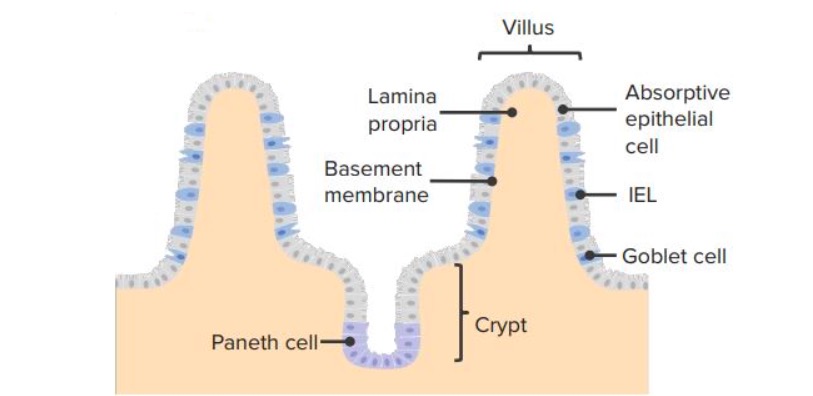Playlist
Show Playlist
Hide Playlist
Polymorphism and TCR Recognition of Major Histocompatibility Complex – Antigen Processing and Presentation
-
Slides Processing & Presentation of Antigen.pdf
-
Reference List Immune System.pdf
-
Download Lecture Overview
00:01 So these molecules vary hugely from one individual to another. 00:06 We call them polymorphic. 00:08 In fact the MHC genes are the most polymorphic genes in the whole of the human genome. 00:15 So why is that? Why do they vary so much from one individual to another? Well the most likely reason is that during evolution, they have diversified so that at least at a population level, there is a huge diversity of MHC that is able to present to T-cells almost any pathogen that might arise during evolution. So, evolution is worried more about the population level than the individual. So it may be that your MHC molecules may not present peptides from a certain virus, but other people’s will. At the tip of the MHC molecule, there is a peptide binding groove that binds the peptide. And as you can see, in the peptide binding groove there is a beta (β)-sheet floor and there are alpha (α)-helices. And the β-sheet floor and the two α-helices are the bits that vary from one individual to another, and between the different MHC molecules. 01:21 And the same is true for MHC Class II; β-sheet floor and the α-helices are the polymorphic regions that bind the peptide. 01:32 However there are also non-polymorphic regions, not associated with the peptide binding groove. 01:40 And they are important in the binding of other molecules to MHC. 01:45 So for example, the molecule CD8 binds to non-polymorphic regions of MHC Class I whereas the molecule CD4 binds to non-polymorphic regions of MHC Class II. 02:05 The fact that the T-cell receptor has to recognize a combination of peptide MHC which we can abbreviate to a lowercase pMHC, ensures cell-cell contact. 02:20 So here we can see an MHC Class I molecule presenting peptides. 02:25 And this is going to present those peptides to a CD8+ cytotoxic T-cell. 02:32 So we have a cell infected with a virus for example, that viral… virus will be broken down and its proteins will be chopped up into peptides and put together with the MHC molecule. 02:43 And the T-cell receptor will recognize a combination of the peptide plus MHC Class I. 02:50 And because this cell is a CD8+ cytotoxic T-cell, it will recognize peptides presented by MHC Class I. 03:00 And that’s an absolute correlation. 03:02 If a T-cell is a CD8+ T-cell, it recognizes peptides presented by MHC Class I, if it’s a CD4+ T-cell, it recognizes peptides presented by MHC Class II without exception. 03:20 And following that interaction between the T-cell receptor and the peptide MHC Class I, and the CD8 binding to non-polymorphic regions, a peptide, a pMHC Class I, there’ll be a signal sent in to the nucleus of the T-cell. 03:38 This will result in activation of the cytotoxic T-cell, and this will kill the infected cell using either the fas-fas ligand pathway of inducing apoptotic cell death or the perforin-granzyme pathway of causing apoptotic cell death in the infected cell; either way that cell will be destroyed and will no longer serve as a home for the virus. 04:04 In terms of recognition of peptide MHC Class II as we’ve already heard, unlike MHC Class I which is found on all nucleated cells, and it needs to be because any nucleated cell can become infected with some virus or another. 04:19 So that needs to be a universal mechanism. 04:21 So all nucleated cells need to have MHC Class I. 04:25 But the job of activating helper T-cells and regulatory T-cells can be given over to a specialized group of cells, and this is the professional antigen presenting cell. 04:35 And they are able to show peptides to the T-cell receptor on CD4+ cells. 04:43 And the vast majority of CD4+ cells are either helper T-cells or regulatory T-cells. 04:47 And again, subsequent to binding of the T-cell receptor peptide MHC, a signal is sent into the T-cell to activate it. 04:56 And this will result in the release of cytokines from helper T-cells and also regulatory T-cells can secrete cytokines and they can also suppress immune responses in a cell-cell contact dependant way; which again is a good reason why there needs to be this intimate interaction enforcing the cell-cell contact by the T-cell receptor on the surface of the T-cell interacting with peptide MHC on the surface of the professional antigen presenting cell. 05:26 And these cytokines that are released will act locally within the environment in which the T-cell is being stimulated.
About the Lecture
The lecture Polymorphism and TCR Recognition of Major Histocompatibility Complex – Antigen Processing and Presentation by Peter Delves, PhD is from the course Adaptive Immune System. It contains the following chapters:
- Polymorphism of MHC
- TCR Recognition of Peptide-MHC
Included Quiz Questions
Cluster of differentiation 8 (CD8) binds to which of the following sites on the major histocompatibility complex (MHC)?
- Non-polymorphic zone of the MHC class I
- Polymorphic zone of MHC class I
- Non-polymorphic zone of MHC class II
- Polymorphic zone of MHC class II
- Either polymorphic or non-polymorphic zone of MHC classes I or II
In major histocompatibility complex class II, the antigen-binding groove consists of which components?
- Two α-helixes and β-sheet floor
- Two β-helixes and α-sheets
- One α-helix and two β-sheet floors
- One β-helix and two α-sheets
- Two α-helixes
The perforin-granzyme pathway is initiated by cytotoxic T cells via the binding of which of the following major histocompatibility complex (MHC) molecules and receptors?
- MHC class I to T-cell receptor plus CD8 co-receptor
- MHC class II to T-cell receptor plus CD8 co-receptor
- MHC class I to T-cell receptor plus CD4 co-receptor
- MHC class II to T-cell receptor plus CD4 co-receptor
Which major histocompatibility complex (MHC) molecules bind to helper/regulatory T cells to initiate cytokine release?
- MHC class II presents peptides to CD4+ T cells.
- MHC class II presents peptides to CD8+ T cells.
- MHC class I presents peptides to CD4+ T cells.
- MHC class II presents peptides to CD4+ and CD8+ T cells.
Customer reviews
5,0 of 5 stars
| 5 Stars |
|
5 |
| 4 Stars |
|
0 |
| 3 Stars |
|
0 |
| 2 Stars |
|
0 |
| 1 Star |
|
0 |




